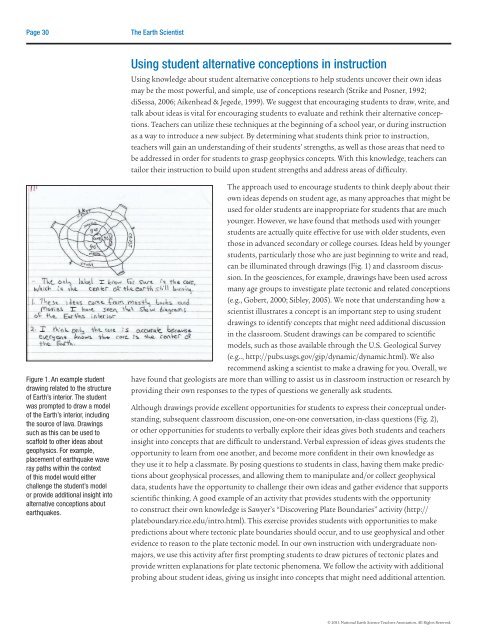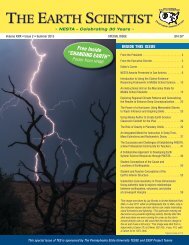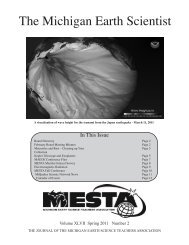The Earth Scientist
The earTh ScienTiST - NESTA
The earTh ScienTiST - NESTA
You also want an ePaper? Increase the reach of your titles
YUMPU automatically turns print PDFs into web optimized ePapers that Google loves.
Page 30<br />
<strong>The</strong> <strong>Earth</strong> <strong>Scientist</strong><br />
Using student alternative conceptions in instruction<br />
Using knowledge about student alternative conceptions to help students uncover their own ideas<br />
may be the most powerful, and simple, use of conceptions research (Strike and Posner, 1992;<br />
diSessa, 2006; Aikenhead & Jegede, 1999). We suggest that encouraging students to draw, write, and<br />
talk about ideas is vital for encouraging students to evaluate and rethink their alternative conceptions.<br />
Teachers can utilize these techniques at the beginning of a school year, or during instruction<br />
as a way to introduce a new subject. By determining what students think prior to instruction,<br />
teachers will gain an understanding of their students’ strengths, as well as those areas that need to<br />
be addressed in order for students to grasp geophysics concepts. With this knowledge, teachers can<br />
tailor their instruction to build upon student strengths and address areas of difficulty.<br />
Figure 1. An example student<br />
drawing related to the structure<br />
of <strong>Earth</strong>’s interior. <strong>The</strong> student<br />
was prompted to draw a model<br />
of the <strong>Earth</strong>’s interior, including<br />
the source of lava. Drawings<br />
such as this can be used to<br />
scaffold to other ideas about<br />
geophysics. For example,<br />
placement of earthquake wave<br />
ray paths within the context<br />
of this model would either<br />
challenge the student’s model<br />
or provide additional insight into<br />
alternative conceptions about<br />
earthquakes.<br />
<strong>The</strong> approach used to encourage students to think deeply about their<br />
own ideas depends on student age, as many approaches that might be<br />
used for older students are inappropriate for students that are much<br />
younger. However, we have found that methods used with younger<br />
students are actually quite effective for use with older students, even<br />
those in advanced secondary or college courses. Ideas held by younger<br />
students, particularly those who are just beginning to write and read,<br />
can be illuminated through drawings (Fig. 1) and classroom discussion.<br />
In the geosciences, for example, drawings have been used across<br />
many age groups to investigate plate tectonic and related conceptions<br />
(e.g., Gobert, 2000; Sibley, 2005). We note that understanding how a<br />
scientist illustrates a concept is an important step to using student<br />
drawings to identify concepts that might need additional discussion<br />
in the classroom. Student drawings can be compared to scientific<br />
models, such as those available through the U.S. Geological Survey<br />
(e.g.., http://pubs.usgs.gov/gip/dynamic/dynamic.html). We also<br />
recommend asking a scientist to make a drawing for you. Overall, we<br />
have found that geologists are more than willing to assist us in classroom instruction or research by<br />
providing their own responses to the types of questions we generally ask students.<br />
Although drawings provide excellent opportunities for students to express their conceptual understanding,<br />
subsequent classroom discussion, one-on-one conversation, in-class questions (Fig. 2),<br />
or other opportunities for students to verbally explore their ideas gives both students and teachers<br />
insight into concepts that are difficult to understand. Verbal expression of ideas gives students the<br />
opportunity to learn from one another, and become more confident in their own knowledge as<br />
they use it to help a classmate. By posing questions to students in class, having them make predictions<br />
about geophysical processes, and allowing them to manipulate and/or collect geophysical<br />
data, students have the opportunity to challenge their own ideas and gather evidence that supports<br />
scientific thinking. A good example of an activity that provides students with the opportunity<br />
to construct their own knowledge is Sawyer’s “Discovering Plate Boundaries” activity (http://<br />
plateboundary.rice.edu/intro.html). This exercise provides students with opportunities to make<br />
predictions about where tectonic plate boundaries should occur, and to use geophysical and other<br />
evidence to reason to the plate tectonic model. In our own instruction with undergraduate nonmajors,<br />
we use this activity after first prompting students to draw pictures of tectonic plates and<br />
provide written explanations for plate tectonic phenomena. We follow the activity with additional<br />
probing about student ideas, giving us insight into concepts that might need additional attention.<br />
© 2011 National <strong>Earth</strong> Science Teachers Association. All Rights Reserved.






